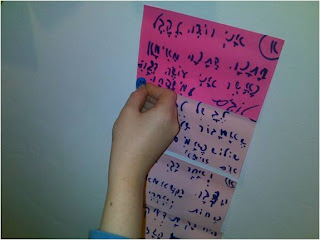Everything we need to succeed is here:
1. Agile creates visibility. Visibility in turn creates security and
control.
When I see where I’m supposed to go, I feel safe. Imagine you’re driving
in the rain, at night. Now imagine you’re driving on a clear sunny day. Which
one makes you feel safer?
2. Agile
Kids enables you to clearly set challenges.
Our
children put up everything on the board. They see what they are up against. It
isn’t a vague in their heads. It is there, and belongs to them. They can see
what is more and less important, it gives them a sense of control, reduces the
confusion and leads them to success. They can also see their progress.
I will
really ask my children, what do they intend to do tomorrow, next week or next
month. And if you are planning a month in advance, what are you going to do?
These tasks will go on the board, and we’ll see progress.
Prioritize
your tasks:
This
doesn’t mean that we’ll need a board every time we want to challenge ourselves
- not at all. In the future, we won’t need the board at all.
3.
Challenges according to age and ability
Each
child chooses their own tasks, and moves forwards at their own pace. The board
belongs to the family, and we each have our own tasks. Danny has tasks that are
suitable for a first grader, and 12 year old Lisa already has tasks such as
babysitting her brother when Mom is late from work. This way, the success is
relative and suitable for each age. On the other hand, we can also see where we
can move forwards. We see others’ successes and failures, and the children talk
to the parents during the daily or weekly meetings, and they learn from their
experiences.
4. The
key word here is trust
I am training
myself and my children to see what lies ahead. We are training to divide our
tasks into doable actions. I am showing them the way. How a task is created,
what happens during the progression, and how it ends. The training will make
the board obsolete, but the principle remains the same. I experience successes
(because I completed tasks), I saw the way, and I learned how to accomplish
this.
5.
Success is key
I’ll say
it again. Children aren’t born with the ability to manage projects. They have
to learn how to. They don’t always know how to divide their assignments into
tasks, and some learn slower and some learn faster. What’s important is the
feeling of success. They don’t need large rewards to feel they were successful
- all they need is a smile and to succeed at their homework. That’s enough for
them.
6.
Listening
Listening
to the children and listening to ourselves. It’s vital to succeed. Listening to
what they have to say about their tasks during the daily meetings, giving them
a place to be heard and to express themselves. When I speak, I’m learning and
developing. When people listen to me and react to what I say, that strengthens
the learning a thousand fold.
7.
Empowerment
Setting
these small goals, even from a young age, and enabling the child to choose
their own tasks, is the basis for empowerment (we’ve written more about it here). And empowerment is one of the best ways to
succeed.
8. The
daily family pulse
The
daily meetings and the order they bring to the house, send out a message. A
message of doing, of support from others when I get stuck. I personally
believe, that without these values, luck will be a major factor in our future
successes, not our own actions or initiatives.
9.
Initiative as a state of mind
Initiative
is part of empowerment. The children are encouraged to take the initiative.
Think of tasks, ask for help from others, and make things move when they get
stuck. This isn’t just encouraged - it becomes a state of mind.
10. The
state of mind and messages that come from the family and the house affect your
children outside as well
For
example, a singer’s son can become a singer with less effort than others. It’s
not just the voice - you have to think like an artist as well, to know how to
express your feelings, create, and so on, which is something that the child is
immersed in at home every day. The same goes for doctors, or business people.
Now,
just imagine that you immerse your children in empowerment. Every day, things
that come naturally to them, will affect them in the future. Everyone agrees
that it doesn’t matter HOW you raise your kids, it affects them a whole lot
more than any courses they might take in the future. So isn’t it in our best
interests to make sure they get confidence, empowerment, and the ability to
follow tasks through?





















